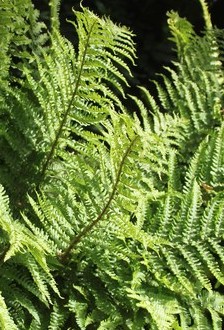 Male fern is a semi-evergreen native to Europe, Asia and North America where it grows in damp woodlands as well as rocky areas. The plants have a rhizome with a single crown and medium green arching fronds. Each frond may be over three feet long and is divided into twenty to thirty five pairs of leaflet like structures that are lobed. The fruiting bodies (sori) have a kidney shaped covering (indusium) and are lined up singly on the upper part of the frond nearer the midrib than the margin. Although the plants like moist soil they become quite drought tolerant once established. Compared to other ferns they also tolerate more sun and alkaline soil. An excellent choice for a shade or woodland garden. The genus name Dryopteris comes from the Greeks words dryas meaning oak and pteris meaning fern a reference to the fact that some species are associated with oak woodlands. The specific epithet filix mas means male fern and refers to vigorous and robust nature of the plant. Genus name from Greek dryas meaning oak and pteris meaning fern in reference to the presence of some species of wood ferns in woodland areas populated with oaks. The specific epithet means male fern in reference to the somewhat vigorous growing habits of ferns in this species.
Male fern is a semi-evergreen native to Europe, Asia and North America where it grows in damp woodlands as well as rocky areas. The plants have a rhizome with a single crown and medium green arching fronds. Each frond may be over three feet long and is divided into twenty to thirty five pairs of leaflet like structures that are lobed. The fruiting bodies (sori) have a kidney shaped covering (indusium) and are lined up singly on the upper part of the frond nearer the midrib than the margin. Although the plants like moist soil they become quite drought tolerant once established. Compared to other ferns they also tolerate more sun and alkaline soil. An excellent choice for a shade or woodland garden. The genus name Dryopteris comes from the Greeks words dryas meaning oak and pteris meaning fern a reference to the fact that some species are associated with oak woodlands. The specific epithet filix mas means male fern and refers to vigorous and robust nature of the plant. Genus name from Greek dryas meaning oak and pteris meaning fern in reference to the presence of some species of wood ferns in woodland areas populated with oaks. The specific epithet means male fern in reference to the somewhat vigorous growing habits of ferns in this species.
Type: Semi deciduous perennial fern
Bloom: Not applicable
Size: 3’ H x 3’ W
Light: Part shade to shade
Soil: Humus-rich, moist, well-drained; tolerates drought once established.
Hardiness: Zones 4-8
Care: Remove dead fronds in spring as the new fronds appear.
Pests and Diseases: None of significance
Propagation: Division of crowns, spores
Companion Plants: Azalea, camellia, Japanese forest grass (Hakonechloa); rhododendron, astilbe , fringed bleeding heart (Dicentra exima), Virginia bluebells (Mertensia virginica), foam flower (Tiarella cordifolia), false Solomon’s seal (Smilacina racemosa)